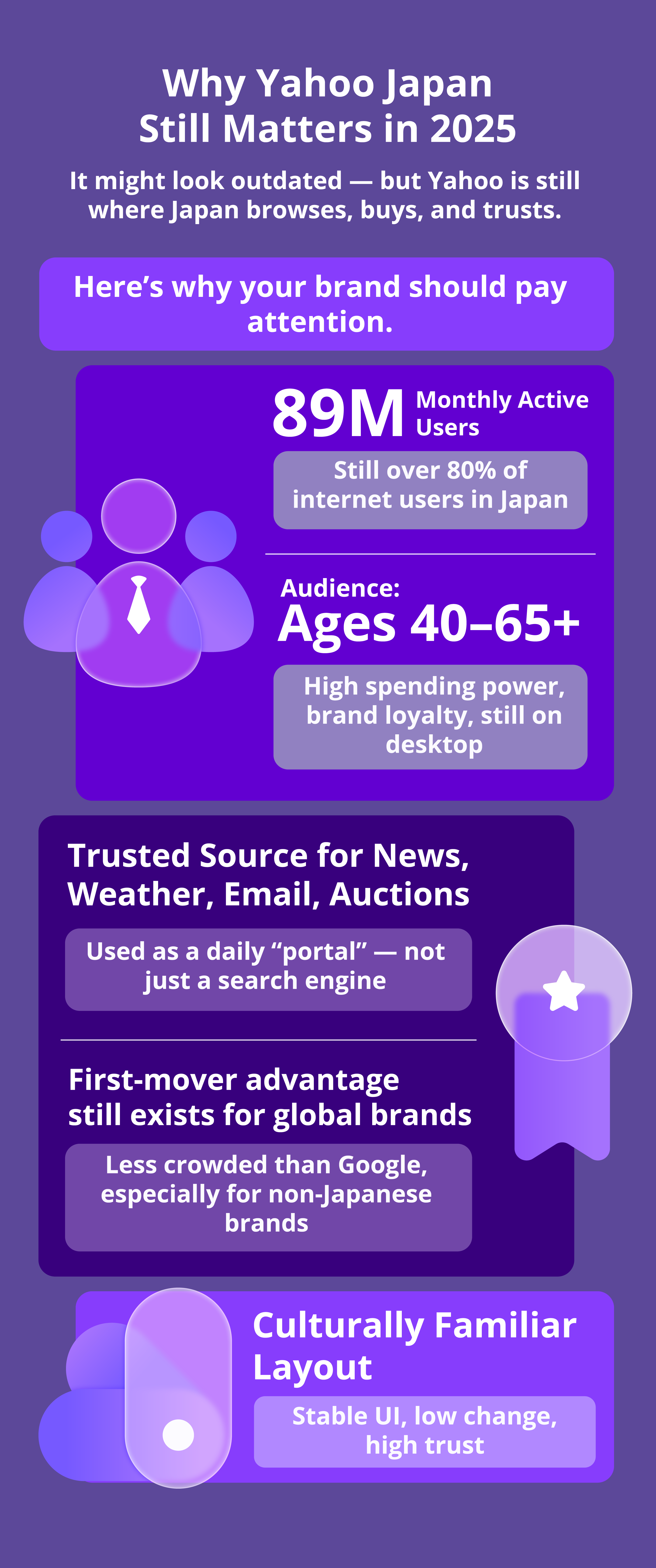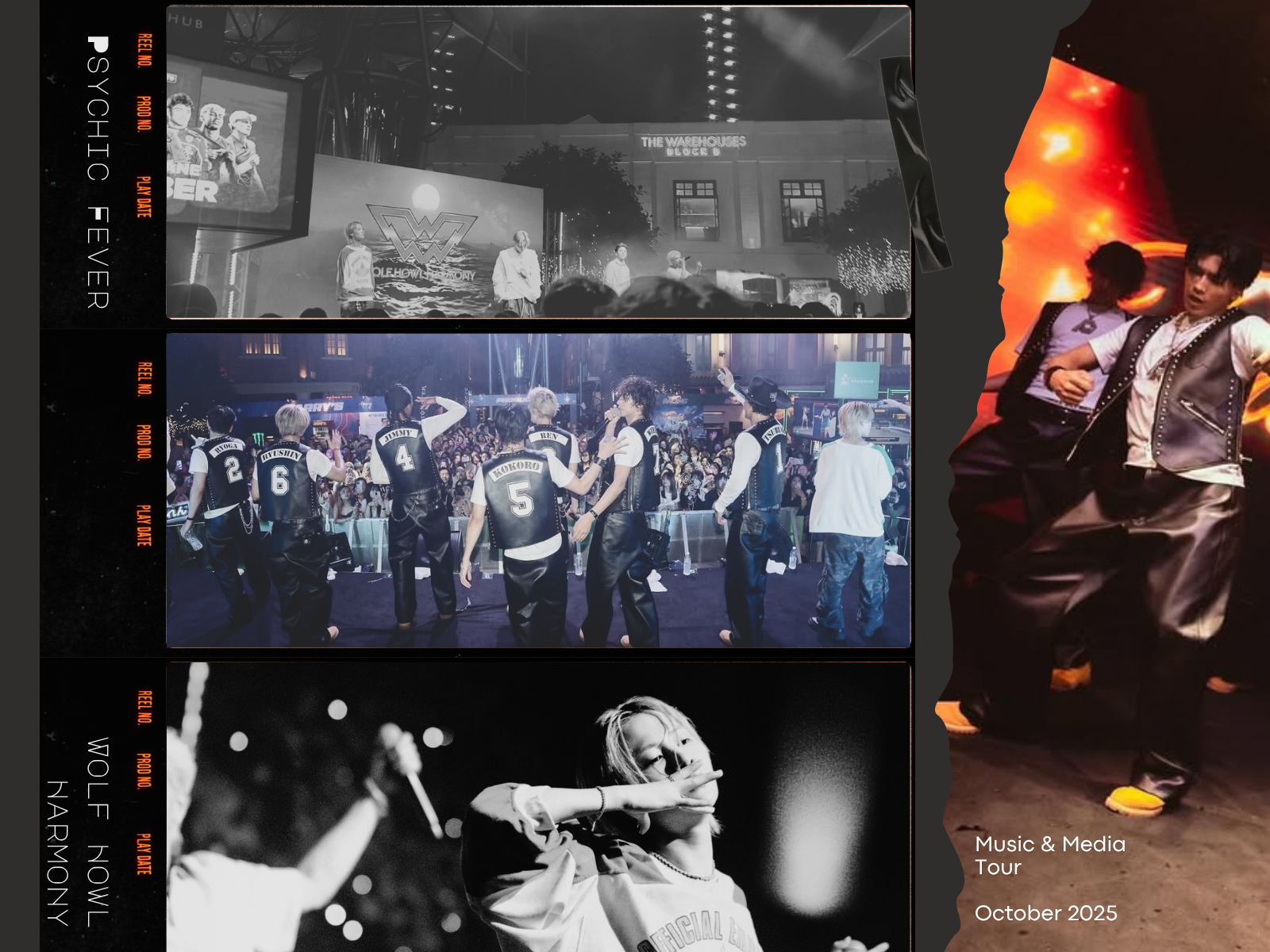When most international brands think about digital advertising in Japan, their strategy includes the big platforms (Google, Meta, TikTok, YouTube etc). But there’s one platform they almost always overlook —and it’s Yahoo Japan.
In Japan, Yahoo is still one of the most trusted and widely used platforms in the country — with more daily engagement than many realize. If your brand is serious about reaching Japanese consumers, especially the older and higher-spending audiences, then Yahoo Japan Ads isn’t optional but essential.
I’ll explain why Yahoo Japan still matters, how it differs from other ad platforms, and what makes running ads in Japan a specific challenge that global marketers need to approach differently.
TL;DR — Why You Should Consider Yahoo Ads in Japan
- Yahoo Japan still reaches over 80% of internet users, especially among older audiences aged 40–65 who trust and use it daily for news, weather, and search. As Japan has the world's most aging population - this is an important context.
- On the flipside, if your brand targets a younger, fast-moving audience, TikTok might make more sense.
- On the flipside, if your brand targets a younger, fast-moving audience, TikTok might make more sense.
- It’s a uniquely Japanese platform — with local cultural targeting, seasonal ad tools, and lower CPCs than Google in many industries.
- Japanese users value trust, consistency, and localized content — strong performance depends on fully localised content (not just a google translate!), nuance, and visual style.
- Campaigns on Yahoo Ads typically need longer timelines, desktop-friendly creatives, and messaging that earns attention slowly. This is again due to the older user-base. So we’re recommending running awareness campaigns BEFORE conversion campaigns.

Really? Why is Yahoo still relevant in Japan?
To most users and marketers outside of Japan, Yahoo might feel like a relic - and look VERY outdated as far as its interface. But here it remains a daily tool for tens of millions of users.
1. Yahoo Japan Is a Portal that feels familiar (Not Just a Search Engine)
Yahoo Japan functions more like a one-stop hub for news, weather, shopping, auctions, sports results, stock prices, train delays, and even disaster alerts. This is what makes it feel much more ‘Japanese’. The homepage is an information-rich dashboard for locals — it’s not just a search function.
Many Japanese users go to Yahoo not just to look for things, but to browse, check the news, or simply stay informed. For some strange reason, I use it to check the weather forecast often in Japan! It just ‘feels’ more accurate than my Apple weather app.
2. Legacy Relationships with Telcos and Email
Yahoo’s early partnership with SoftBank and mobile carriers meant it was installed by default on millions of phones in the 2000s. Even today, millions of people still use Yahoo Mail as their main email provider — which keeps them inside the Yahoo ecosystem for other services. Much like flip phones in Japan - This trust and familiarity once built has been hard to break, making it such a sticky platform.
3. Desktop Usage Is Still Strong
In Japan, especially among users aged 40–65+, desktop browsing is still the norm. Many office workers use Yahoo throughout the day at work (and windows is much more prevalent than Mac). Unlike mobile-first audiences elsewhere, this generation is more likely to be on Yahoo via a desktop browser during working hours.
This affects your ad strategy too — you can’t rely on mobile-optimized content alone, but also factor in desktop users on Yahoo.
4. The design is still old and ‘familiar’
Yahoo’s interface hasn’t changed much over the years (and yes, many UI/UX designers look at it and wail) — But that’s part of why users stick with it. It’s familiar, tidy, and feels safe. In a country where design, predictability, and ease of use are prized, Yahoo feels familiar in a very Japanese way. The older Japanese users on Yahoo aren’t necessarily looking for what’s new — they’re looking for what works. Yahoo fits that user behaviour and explains why they find it hard to switch over to google or searching using Gen Ai.
What Makes Yahoo Ads Different from Google Ads?
At a glance, Yahoo’s search ads look a lot like Google Ads — keyword-based, pay-per-click, text formats. But if you’re running Yahoo Ads in Japan, there are deeper differences to understand:
1. The Audience Behavior Is Different
Google users in Japan skew younger, mobile-first, and global-facing. They want results instantly. Yahoo users tend to be older, more conservative, and more deeply rooted in local habits. They also want results instantly, but behaviorally will take more time to decide which results to click through to, or look into the website giving them the information to ensure credibility.
The audience on Yahoo also doesn’t respond to the same ad styles. They need more information. They’re more sensitive to tone. Your copy can’t be casual or overly aggressive — it needs to educate, build trust, and feel familiar.
The easier analogy is to imagine google search as the big, attention-deficit city of Tokyo - and Yahoo Ads as the calmer, cultural city of Kyoto.
2. Less Competition = Lower CPCs
Many global brands overlook Yahoo entirely. That means less bidding competition in many industries, and often lower cost-per-click — especially for traditional sectors like real estate, travel, finance, or events.
It’s one of the few platforms where the “first mover” advantage still exists for foreign brands.
3. Targeting Built for Japan
Yahoo offers audience segments unique to Japan: local sports fans (e.g. sumo, not just general “sports”), regional event followers, izakaya diners, rakugo fans, and more. This type of targeting doesn’t exist on Google or Meta.
These audiences are built using Yahoo Japan’s proprietary content behavior and are more aligned with local interests and culture.
4. Platform Expectations Are Different
The Yahoo Japan user experience is more conservative and traditional. Your ad copy, design, and tone must match that.
- Flashy CTAs or all-caps will feel out of place to the older audience.
- Visual creatives must be tidy and respectful
- Overuse of English can reduce trust instead of adding appeal.
Think of it more like a Japanese newspaper ad, not a TikTok post!
Why Japanese Users Prefer Yahoo
Understanding why Japanese users stick with Yahoo is the first step to crafting campaigns that perform well. Here are a few key points:
Trust and Familiarity
Compared to other countries, Japanese consumers may seem very conservative. They prefer brands and platforms that have a long-standing reputation which gives them a sense of comfort and trust. Yahoo in particular has been in the Japan market since the late ’90s and is perceived as trustworthy — especially compared to newer or foreign alternatives who come into the market quickly and often fizz out quickly.
Millions of users check Yahoo several times a day — for weather, news, event updates, and more. These aren’t passive scrollers — they’re engaged users with a reason to visit. Your ads, therefore, appear in a moment of purpose.
Combined with Yahoo’s high local brand equity, this creates strong ad recall and high-quality traffic.
Comfort With Japanese-First Content
Even among the global-savvy Japanese consumers, there’s a preference for content that feels made for Japan. This means not just the language, but the layout, tone, and design. Yahoo provides that experience. Foreign brands that rush-translate their content to Japanese, or who don’t take time to localize properly often stand out - as something ‘not local’, impacting the campaign in a bad way.
What unique features does Yahoo Ads offer?
Yahoo’s ad structure is pretty similar to your Google Ads campaigns - keyword targeting, PPC search ads, and display formats. But there are some features tailored to the Japanese market that could be useful to your strategy:
1. Cultural Targeting that is specific to Japan
There are some targeting settings that allow for deeper cultural segmentation based on local behaviors and content preferences, for example:
- Targeting users who browse izakaya reviews, follow rakugo or noh theatre, or check regional event calendars (ie, some deeper niches)
- Tap into audiences interested in sumo, domestic travel, or even traditional crafts
These segments are driven by Yahoo’s own ecosystem data — built around how Japanese users engage with news, weather, shopping, and search — giving your campaigns higher cultural accuracy and stronger relevance.
2. Seasonal & Regional Precision
Yahoo makes it easy to match campaigns with Japan’s seasonal rhythms and regional context — which are key to user behavior here. You can align your targeting with:
- Holidays (Golden Week, Obon, Emperors Birthday, etc)
- Regional Events (local festivals, prefecture-specific happenings)
- Seasonal activities (hanami, typhoon season, pollen season, year-end gifting)
Seasonal cycles impact consumer behaviour in Japan - so being able to manage your campaign with these tactics is helpful.

Best Practices for Yahoo Ads in Japan
1. Start with Brand Awareness to build trust with Japanese customers - before moving into Conversion Campaigns
If your brand is new to the Japanese market, aiming for immediate conversions can be a fast way to burn your budget. In Japan, trust is everything — and trust takes time.
Instead of hard-selling right away, introduce your brand in a way that aligns with local expectations. This might mean starting with:
- Informational ads that explain who you are, why you exist, and your relevance to Japan
- PR-style messaging or subtle storytelling rather than “Buy Now” offers
- Display or search campaigns focused on visibility, not cost-per-acquisition
Credibility is the key currency in Japan. Users are far more likely to convert after seeing your brand in multiple places over a long period of time — on Yahoo’s homepage, in the news feed, and alongside relevant search results. Integrating brand awareness campaigns early not only builds recognition, but sets your brand up to benefit from trust-based conversions for the long term. Only once awareness is built should you shift to conversion targeting.
2. The more fully you Localize your content and strategy, the better your results will be.
The most common mistake I see are brands that assume simple ‘translated’ Ad campaigns will work in Japan. Brands need to localise fully, especially for a context rich language like Japanese.
Search behavior is shaped by cultural nuance. For example, a user might type “cheap and reliable moving service Tokyo” in English — but the equivalent Japanese query won’t be a word-for-word translation. It might be phrased more politely, or use completely different keywords depending on context and age.
Proper localization requires more than language fluency. You need:
- Native Japanese marketers doing keyword research from scratch, not using translation tools
- Local copywriting that reflects cultural tone, formality, and expectations
- Alignment across ads, landing pages, and even the website UX — if your site feels like a global template with Japanese text pasted in, your bounce rate will be high
If in doubt, ask a Japanese person how they feel your Ad creatives come off to local audiences. Chances are they will immediately spot something ‘unnatural’ if your creative has been just quickly translated.
3. Structure your Ad Groups Around Intent and Japanese seasonality.
Yahoo’s ad platform performs best when campaigns are well-structured and tightly themed. Instead of lumping multiple products or services into one campaign,try to make them distinct categories, with a single user objective.
Here’s some recommendations:
- Split by product or service category — Being more specific help. “Shoes” is too broad; “Men’s Leather Work Shoes” is clearer.
- Segment by user intent — someone researching an event isn’t ready to buy tickets. Tailor messaging to whether they’re in awareness, consideration, or conversion stages.
- Regional or seasonal targeting — Japan has strong seasonality (e.g. cherry blossom season, typhoon season, summer festivals), and Yahoo offers great location-level targeting. You should match the season to the local mood and behavior.
In short, ensure people see an ad that makes sense for where they are in their journey — something particularly important in Japan, where linear decision-making is more common than impulsive buying.
4. Keep in mind devices in Japan (web over mobile)
Yahoo’s user base includes a large number of older users who still rely on desktop computers, particularly during work hours or for online shopping. In your other markets you’re likely optimising for purely mobile - however you shouldn’t leave out desktop as it still dominates. In particular we see performance shifts quite dramatically within industries such as travel, insurance, or high value goods like watches, high-end clothing brands.
During your campaign, ensure that you:
- Review device-level reporting regularly — don’t assume mobile will outperform in Japan.
- Design landing pages and creative assets that render well on older desktop browsers (yes we’ve even seen internet explorer!)
- Consider the context: older users at work may have more time and attention to research, which suits the slower, more deliberate buying journey common in Japan
Short breakdown of the most common Mistakes Foreign Brands Make in Japan
Based on the brands we’ve helped or seen running ads on Yahoo Japan, here’s a summary of the most common mistakes to avoid, along with some suggestions to fix it:
1. Translating Ads, Not Localizing Them
Fix: Work with local Japanese copywriters who can adapt the nuance, politeness level, and structure of your creatives.
2. Ignoring Desktop Optimization
Fix: Try to design for both mobile and desktop — and test on older browsers too.
3. Copying Google Campaigns
Fix: Treat Yahoo as its own media channel with its own audience logic.
4. Running Short-Term Campaigns
Fix: Think in longer cycles — 6–8 week plans with brand warm-up & awareness phases to build trust, before conversion campaigns.
5. Using Global Keyword Lists
Fix: Run local keyword research with native speakers and test different variants.
6. Forgetting Seasonality
Golden Week, Obon, school graduation, pollen season (kafunsho) - Much of Japan’s consumer behaviour is linked to the calendar. Make sure your marketing team know them!
Wrapping up,
I hope the insights above gave you a better understanding of Yahoo Ads. Maybe you can take some of the insights into your next campaign.
If you have feedback, questions, or want to share ideas - contact us - I’m always happy to catch up for a chat.
And of course, if you’d rather not deal with all the campaign setup, localization, or ongoing optimization… our agency Geezerbuild can do it all for you. Just get in touch.
Written by Taisuke Yamamoto - Founder, Geezerbuild. I’m based in Tokyo and our ads team helps brands enter the Japan market using digital advertising.


.png)




.png)

.png)

.png)
%20-%20Aiko%20-%20social%20media%20advertising%20(1).png)
.jpg)
%20(1)-min.jpg)
%20(3)%20(1)-min.jpg)
%20(2)-min.jpg)
-min.jpg)

-min.jpg)






%20-%20Orisaka%20Yuuta%20Spell%20Tour%202024%20(1).png)
%20-%20SALASA%20GOLDEN%20CHILD%20TOUR%202024%20(3)%20(1).png)
%20-%20Dios%20Gasoline%20Tour%202024%20(1).png)
%20(1).png)
.png)
.png)



.png)














